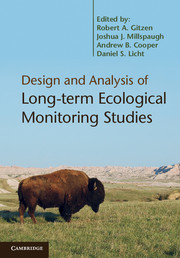Book contents
Foreword: Ecology, management, and monitoring
Published online by Cambridge University Press: 05 July 2012
Summary
Ecological monitoring has a somewhat checkered history, in part because it has been a fuzzy concept. It has ranged from measuring a single variable at a single location over time to measuring multiple variables at a national scale, sometimes with quantitatively defensible designs and sometimes not. Most currently accepted definitions include measuring in some convincing way (and that adjective is critical) some aspect of ecological composition, structure, or function over time. In the past, managers have received more rewards from doing things than understanding the effectiveness of what they did. Funding for ecological monitoring, therefore, has been variable and usually has been the first victim of budget cuts. The scientific community has also been partly to blame. Where monitoring was employed, sometimes the wrong thing was measured, or measured in the wrong way. Monitoring was often designed with little attention to a conceptual framework, and seldom had a firm tie to policy and decision making.
In part due to this history, research and monitoring have been viewed as two distinct and separable activities. The former was seen as controlled, largely experimental, and rigorous, while the latter was seen as uncontrolled, largely observational, and inexact. This distinction has thankfully faded over time, and now research and monitoring are seen more as a continuum (Busch and Trexler 2003). Research is generally stronger at determining cause and effect. Monitoring contributes a spatial and temporal depth that is less commonly seen in research, and both are capable of testing hypotheses.
- Type
- Chapter
- Information
- Design and Analysis of Long-term Ecological Monitoring Studies , pp. xiii - xvPublisher: Cambridge University PressPrint publication year: 2012

